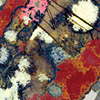Could you cite some sources of information regarding claramine?
A Pubmed search found only these two articles, neither of which seems germane:
I think the second citation is relevant. Pls read the full paper. It has the same effects as trodusquamine, but is less potent at equivalent doses in terms of its PTB1B inhibition.
"In search of new selective inhibitors of PTP1B to improve insulin
signaling and glycemic control for type II diabetes, we tested an
analog of Trodusquemine, a known selective inhibitor of PTP1B.
Here, we report that a novel and easily manufactured compound
Claramine is also a selective inhibitor of PTP1B. Like Trodusquemine,
Claramine had a strong insulin-mimetic action in neuronal
cells and rapidly restored glycemic control and insulin sensitivity in
diabetic mice. In addition, a single dose of Claramine transiently
suppressed food intake causing weight loss in mice.
The observation that a single intraperitoneal administration of
Claramine suppresses feeding behavior indicates that Claramine
can cross the blood brain barrier (BBB). Claramine likely acts on the
hypothalamus, the brain region that orchestrates metabolic homeostasis
by regulating feeding behavior and sympathetic tone to
peripheral tissues [6,39,40]. This is consistent with the action of its
close analog Trodusquemine that is known to cross the BBB and act
on the hypothalamus to suppress appetite [12,13,17e19].
By using neuronal F11 cells we showed that Claramine has an
insulin-like effect, increasing IRb and Akt phosphorylation. Beyond
this effect of Claramine on cultured neuronal cells, Claramine could
also effectively correct insulin resistance in vivo by blocking PTP1B
activity. Although we did not test the effect of Claramine in hepatocytes
or skeletal muscle, a single intraperitoneal injection of
Claramine effectively restored insulin sensitivity and glycemiccontrol in diabetic mice similar to the observed effect of Trodusquemine.
It seems likely that insulin signaling in these tissues is
also restored by Claramine, as has been reported for Trodusquemine
[12,13,18].
Finally, the mechanism whereby Claramine inhibits PTP1B activity
remains unclear. Recent evidence has demonstrated that
Trodusquemine acts as an allosteric inhibitor that binds to two targets
within PTP1B, one near the catalytic domain and another in the
C-terminal, non-catalytic segment of PTP1B [41]. Both targets were
shownto be important since point mutations at both sites (Ser372 to
proline and Leu192 to alanine), preserved catalytic activity but
rendered PTP1B insensitive to Trodusquemine [41]. Claramine has a
spermine structure quasi equivalent toTrodusquemine but lacks the
sulfate present in Trodusquemine. Given that we observe a similar
inhibition of PTP1B activity by Claramine, this suggests that the
sulfate group of Trodusquemine is dispensable for it to block PTP1B
enzymatic activity. On the other hand, we suspect that the OH
moiety present in both Claramine and Trodusquemine may be
critical for PTP1B inhibition. Future studies testing 3-amino and
polyaminosterol derivatives (compound 6i or 8i) described in our
previous publications [21,22] that share a similar structural backbone
to Trodusquemine and Claramine but without the OH moiety
will allow us to further test this hypothesis. Together, these compounds
will help to shed further light on how PTP1B activity can be
blocked by this polyaminosterol class of inhibitors with the goal of
designing a more potent and specific inhibitor analog.
In conclusion, Claramine is an easy to manufacture compound
that selectively blocks PTP1B activity and activates an insulin-like
response through IRb, Akt and GSK3b phosphorylation. Thus,
Claramine may be a potential lead compound for developing new
agents for the treatment of type 2 diabetes.
"























































